Chesapeake Bay Retrievers have been the fisherman’s dog of choice for over a century. Combining agility, endurance, and protection, this is sure one impressive pup.
In its earliest days, these canines were called Brown Winchester, Red Chester, and Chesapeake Bay Ducking Dog. Today, the Chesapeake Bay Retriever goes by Chessie or CBR, for short.
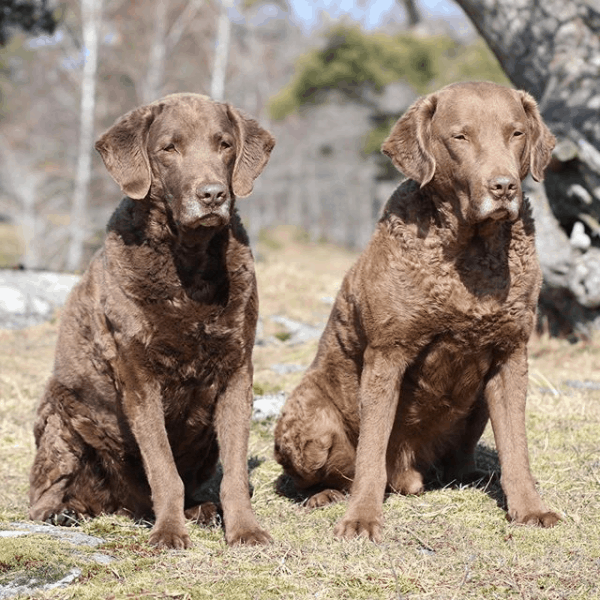
So what is it about Chessies that make them so popular among watermen? Let’s find out!
Quick Navigation
- 1 What is a Chesapeake Bay Retriever?
- 2 What does a Chesapeake Bay Retriever look like?
- 3 Are Chesapeake Bay Retrievers good family dogs?
- 4 Caring for a Chesapeake Bay Retriever
- 5 Does the Chesapeake Bay Retriever have health issues?
- 6 How much does a Chesapeake Bay Retriever cost?
- 7 Chesapeake Bay Retriever vs. Labrador Retriever
- 8 Will the resilient Chesapeake Bay Retriever join your pack?
What is a Chesapeake Bay Retriever?
If you’ve ever spent a winter in the northeastern US, you know that “cold” is an understatement. This is especially true for the northern coast, where icy winds and waters are commonplace.
It was among these conditions that the resilient Chesapeake Bay Retriever came to be.
In 1807, an English ship wrecked just off the coast of Maryland. Among the rescued were two Newfoundland puppies.
When local fishermen took notice of the pups’ retrieving talents, they started breeding their dogs with the Newfoundlands. Over time, this interbreeding gave way to the modern Chessie.
The Chesapeake Bay Retriever quickly became renowned for its retrieving abilities and seemingly unending stamina. Some of these canines have been known to retrieve hundreds of ducks a day!
By 1885, CBRs became officially AKC-recognized (American Kennel Club), making it one of the oldest registered dog breeds in the US. And just under 100 years later, Maryland declared the Chesapeake Bay Retriever its state dog.
Not many breeds have as many claims to fame as the Chessie!
What does a Chesapeake Bay Retriever look like?
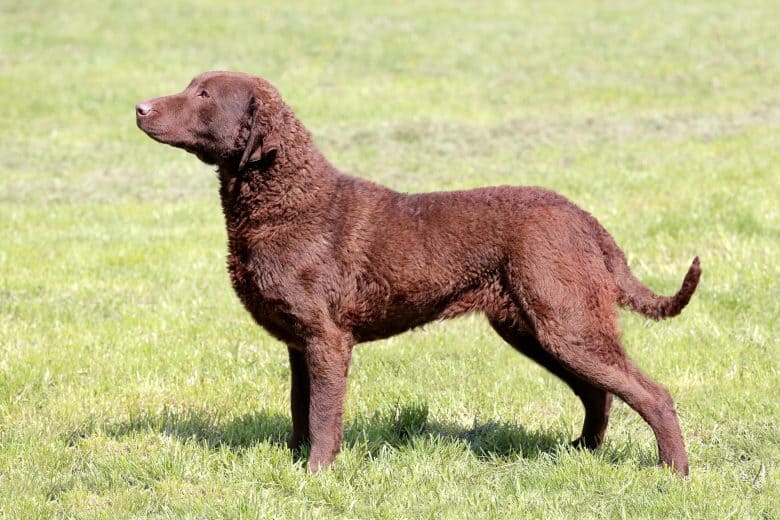
Looking at the CBR’s Lab-like face, you’ll be most struck by their wideset amber or yellow eyes. They have triangular, drooping ears and a longer muzzle. The rest of their body, however, is completely designed for water work.
Their webbed feet and tall back legs enable Chessies to swim against strong winds and currents for hours on end.
Coming in with the assist are this retriever’s wide chest and straight or lightly curled tail. Both of these features help Chessies move through and against chunks of ice.
Chesapeake Bay Retrievers have oily, slightly wavy fur, as well. Their specially-designed coat helps keep them warm during dives into freezing water. It also wicks away moisture, making CBRs naturally water-resistant.
To top it all off, Chessies are covered in a sort of canine camouflage. Their coats come in varying shades of brown, sedge, and deadgrass. They often have one solid color, but they might have patches of white on their chests or feet.
How big are Chesapeake Bay Retrievers?
A full-grown Chessie is no half-pint. Adult males can easily grow to 65-80 pounds (29-36 kg) and measure 23-26 inches (58-66 cm) in height. Females are only slightly smaller, weighing in at 55-70 pounds (25-32 kg) and standing 21-24 inches (53-61 cm) tall.
Between this breed’s retrieving instincts and ample size, the Chesapeake Bay Retriever should not live in apartments.
Do Chesapeake Bay Retrievers shed a lot?
Allergy sufferers, this probably isn’t the best breed for you, as CBRs are heavy shedders.
Their dense undercoat sheds most heavily around spring, but you’ll see a healthy layer of Chessie hair on your furniture year round.
Are Chesapeake Bay Retrievers good family dogs?
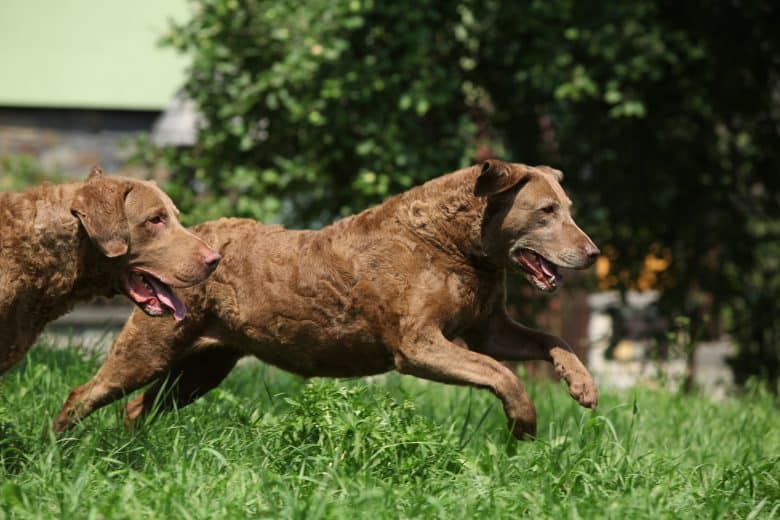
Chessies are interesting canines. They tend to do well with most families, but their personalities are on the picky side.
They have a reputation of being the most watchful of the retriever breeds. They can be playful and affectionate with their pack members, but the hospitality stops there.
And even though CBRs don’t bark a lot, their protective nature makes them the perfect guard dog.
Chesapeake Bay Retrievers are generally standoffish with strangers. Additionally, they don’t always take too kindly to new canine friends. They often do well when raised with other animals, but unknown pets?
They’re either foe or food, and dog aggression is a real possibility.
Some Chesapeake Bay Retrievers are more aloof than others. Don’t feel slighted if your independent Chessie doesn’t always seem interested in snuggles!
On the contrary, even the most reserved CBR bonds closely with her family. Your Chessie pup may not always show it, but she wants nothing more than to be near you.
In fact, this breed can show signs of separation anxiety if they’re left alone for too long.
If you have younger children, you’ll want to teach them how to read your Chessie’s body language. This is especially important if your kids are, shall we say, enthusiastic and your pet is not.
Most Chesapeake Bay Retrievers play nicely with kids of all ages, but they don’t tolerate much rough-housing. They’re also prone to resource guarding, which can spell trouble for eager toddlers.
Always supervise playtime with this breed to ensure everyone’s safety.
You may want to study your dog’s body language, too. Sometimes, they can appear mean or aggressive, but they’re actually just really happy to see you.
Chesapeake Bay Retrievers are known for their vocalizations and “Chessie smile.” If you notice a Chessie curling his lips and baring his teeth, it’s very likely that he’s simply too excited and can’t contain it.
Don’t believe us? Check out how Dakota the Chessie says good morning to his humans! It may seem intimidating at first, but pretty soon, your CBR’s grin will be your favorite part of the day.
This might go without saying, but CBRs aren’t the best canine for first-time dog owners. These retrievers are fantastic dogs that require a great deal of structure to be at their best.
Training and socialization should start early and continue throughout their lifetime. Focus initial efforts on basic obedience, proper introductions, and deferring to your leadership.
This last part is super important! You want your headstrong Chesapeake Bay Retriever to trust your guidance at all times, especially in tense situations.
Independent as they are, the intelligent Chessie loves to learn. These dogs have active, vibrant minds, so training shouldn’t be too difficult with the right approach.
For best results, keep training sessions short and fun. Chesapeake Bay Retrievers get bored easily, so spice up their training regimen with creative games and toys.
Agility, nosework, or flyball training are all excellent choices for the CBR! This pooch will also excel in therapy, search-and-rescue, and police work.
Caring for a Chesapeake Bay Retriever
CBRs are relatively easy to care for. They don’t require much grooming, but you’ll need to invest plenty of time into exercising this breed. Keep reading to find out just how much!
How do you groom a Chessie?
Depending on whether your Chessie is a companion or working dog, they may need or less grooming attention. Overall, though, this is a fairly low-maintenance breed.
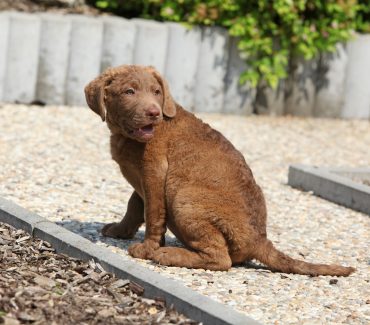
At least once a week, brush your Chessie’s teeth and inspect their ears. If you notice signs of irritation or infection, give your vet a call to find out what’s going on.
On average, weekly brushing will suffice. Don’t bathe your CBR unless it’s absolutely necessary.
Chesapeake Bay Retrievers with frequent access to water–particularly those used for hunting and retrieving–might develop an odor over time. But shampoo can damage their coat’s oils, which can leave them vulnerable to cold temperatures.
You shouldn’t wash your dog’s hair with soap every time they go for a swim, but feel free to give them a good rinse. This can help reduce any lingering doggie stink and keep your dog cleaner during hunting season.
What’s the best diet for a Chesapeake Bay Retriever?
Most adult Chessies need roughly 2 cups of food daily. Look for a dry dog food with a minimum of 20% protein if your CBR is exceptionally active.
You’ll also want to avoid feeding your pup table scraps or unhealthy doggie snacks. Chessies aren’t the type to turn down a treat, so take care not to overfeed them.
Exercise requirements for the Chesapeake Bay Retriever
Chesapeake Bay Retrievers are dynamic, industrious canines. They’re bred for activity, so a sedentary lifestyle simply isn’t an option. Plan on at least an hour of exercise every day.
Just like the Chessie’s training regimen, their exercise routine must be kept interesting. Where some dogs are content with a casual stroll through the park, walks aren’t enough for the Chesapeake Bay Retriever.
Swimming, dock jumping, and duck or quail hunting are much more their speed. These activities not only help Chessies burn energy, they also satisfy a deeper instinctive drive.
If hunting isn’t your jam, retrieving games (like fetch) are a close substitute.
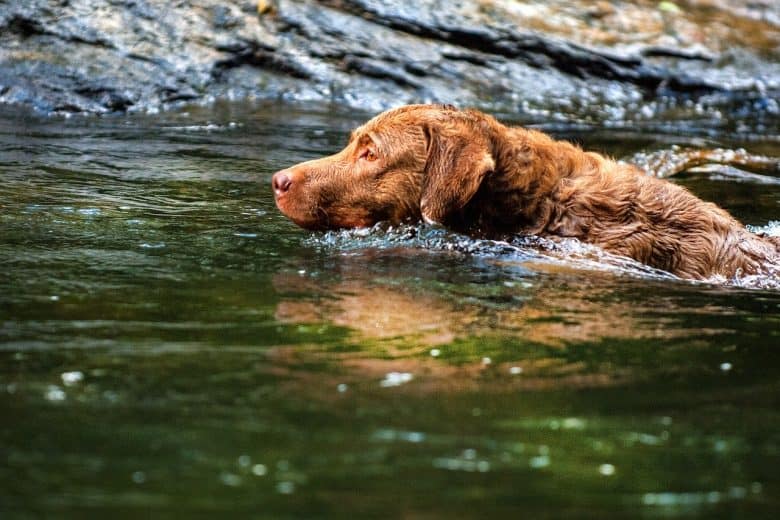
Because of the Chesapeake Bay Retriever’s physical composition, they’re completely cold-weather tolerant.
Hotter climates may be uncomfortable for the Chessie, so take precautions in warmer weather. Limit outdoor exercise to the mornings and evenings, and take your Chessie for a swim to help them cool off.
Does the Chesapeake Bay Retriever have health issues?
CBRs are generally healthy pups. With an average life expectancy of 10-13 years, this pooch will keep you on your toes for a decade or more.
But like all dogs, Chessies are at more risk for certain health conditions than others. Some of the most common include:
- Elbow and hip dysplasia
- Bloat (also called gastric torsion or gastric dilation volvulus)
- Hypothyroidism
- Eye problems, like entropion or progressive retinal atrophy (PRA)
- Epilepsy
- Von Willebrand’s disease
Make sure your CBR pup is screened for genetic conditions before you buy. You’ll also want to schedule vet visits every 6-12 months.
After all, there’s no rule that says Fido can only see the dog doctor once a year. And regular, preventative care is the best way to keep your dog happy and healthy!
How much does a Chesapeake Bay Retriever cost?
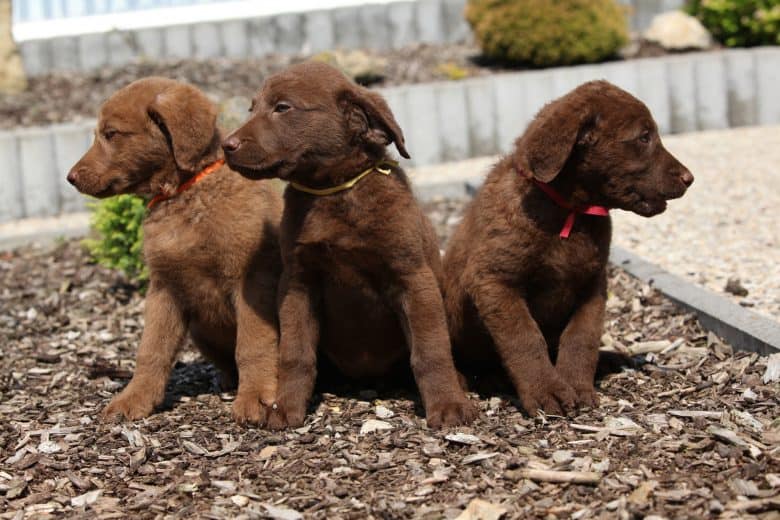
Chessie pups usually cost $1400 USD on the low end. Depending on the litter size and your pup’s pedigree, you could pay over $5000 USD for one of these furballs. For reference, Chesapeake Bay Retriever litters are generally 10 or so puppies.
The good news is that you won’t have any trouble finding a Chesapeake Bay Retriever for sale. The bad news is that you’ll pay an arm and a leg.
Chesapeake Bay Retriever breeders and kennels
No matter where you are in the States, CBR breeders and kennels are easy to find. But not all breeders are created equal.
Look for a kennel that specializes in Chesapeake Bay Retrievers. Ask as many questions as you can think of to gauge your breeder’s expertise.
You should also ask for health certificates for your pup and its parents. You want to be sure that your dog comes from good stock.
Ready to start pinching pennies and saving up for an adorable Chessie pup? Here are a few breeders to jumpstart your search:
- Xanadu Kennels (Magnolia, TX)
- Desert Winds Chesapeake Bay Retrievers (Ranchita, CA)
- LongMeadow Kennels (Dover, PA)
Chesapeake Bay Retriever rescues
Thinking about adopting your Chessie? Bringing home a rescue pup is a great way to give a dog a second chance at life. It’s also much easier on your purse strings!
The CBR is a popular, yet challenging dog. For this reason, you likely won’t have any trouble finding one in need of a forever home.
Start with local shelters, but be willing to broaden your search parameters if need be. Check out these CBR rescues for an idea of what dogs are currently available:
- Chesapeake Safe Harbor (Amherst, MA)
- Chesapeake Bay Retriever Relief & Rescue (Poquoson, VA)
- ACC Rescue (Garden Valley, ID)
Chesapeake Bay Retriever vs. Labrador Retriever
Chessies are often compared to Labrador Retrievers, but just how alike are these breeds?

Both of these dogs were created to serve as reliable sidekicks for hunters and fishermen. As such, Labs and CBRs are exceptional retrievers and truly enjoy working.
Additionally, both love water and share a similar build, with the Chessie being slightly larger.
What really distinguishes these breeds are their temperaments.
The Labrador is much friendlier than the Chessie. A Lab sees a stranger and can’t wait to meet their new best buddy. A CBR sees a stranger and can’t wait to defend the family.
Along those same lines, Labradors tend to be more exuberant and lighthearted. The Chesapeake Bay Retriever, on the other hand, is relatively stoic.
Dog owners looking for a work-oriented watchdog will likely prefer the Chessie. But if you’re in the market for a more neighborly pooch, the chummy Labrador Retriever is a solid choice.
Will the resilient Chesapeake Bay Retriever join your pack?
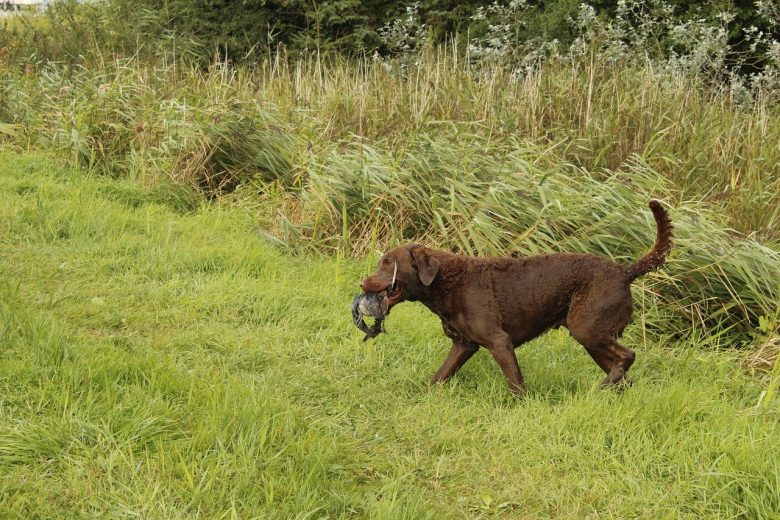
Chesapeake Bay Retrievers are extraordinary canines. Braving the biting cold of Maryland’s waterways, the Chessie exceeded expectations and earned the unofficial title of “toughest retriever.”
When we say tough, we mean it. CBRs are always ready to retrieve or defend, and they’ll do best with owners who know how to handle their impulses.
Think you can match the Chessie’s tenacious spirit? We’d love to hear about it in the comments!
Cess is the Head of Content Writing at K9 Web and a passionate dog care expert with over 5 years of experience in the Pet Industry. With a background in animal science, dog training, and behavior consulting, her hands-on experience and extensive knowledge make her a trusted source for dog owners.
When not writing or leading the K9 Web content team, Cess can be found volunteering at local shelters and participating in dog-related events.
